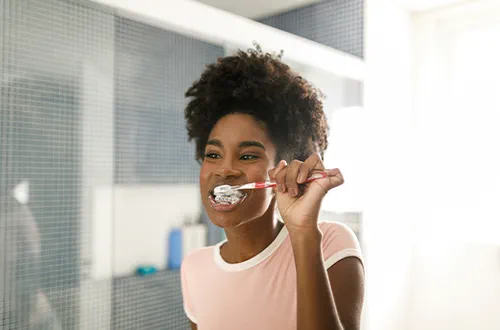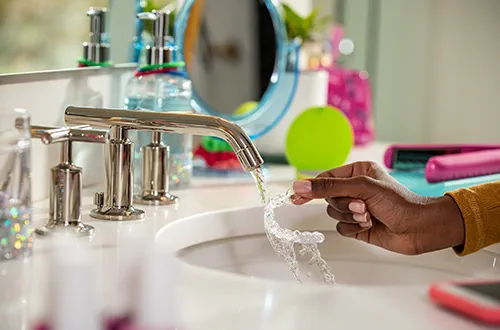Navigation
Looking after removable and fixed braces
Once your braces have been fitted, your orthodontist will give you advice on how to look after them during your treatment. This includes what you can eat and drink, and how to clean your teeth and your braces.
Whether you have fixed braces or removable aligners, you’ll want to make sure you care for them properly so your treatment is successful.
Brushing with braces
If you don’t keep your teeth and gums healthy during treatment, your orthodontist might have to remove your braces or stop your treatment until your teeth and gums are healthy again. As such, you’ll need to be extra careful with daily brushing and flossing.
Food can easily get stuck in fixed braces, and aligners remain in your mouth for long periods. Both can attract the bacteria that forms plaque and tartar, which if not cleaned away, can lead to tooth decay and gum disease.
Our top tips are:

Brush twice a day: Brush your teeth twice a day with fluoride toothpaste for at least two minutes. For those with removable aligners, brush your teeth after eating and before putting your aligners back in your mouth to avoid staining them.
Brush behind the wires: If you have fixed braces, make sure the bristles of your toothbrush get behind the wires of your braces. The easiest way to do this is to tilt your brush at a 45-degree angle downwards when brushing the area above and behind the wires, and then tilt it upwards when brushing the tooth surface below the brackets. Make sure you brush all the way to the gumline.
Flossing is key: Make sure you use floss or an interdental brush to help you clean between the brackets and around your gums.
Remember to continue with your regular dental check-ups, and to attend visits to a dental hygienist throughout your treatment - they will help you make sure you’re keeping your teeth and gums healthy.
Even if you have removable aligners instead of fixed braces, it’s still really important to look after them and keep them clean. You should:
- Rinse your aligners every night and brush them gently with lukewarm water and a soft toothbrush
- Never use toothpaste or hot water, as this could damage them and bend them out of shape
- Use an aligner cleaning solution once a week for a deep clean. Your orthodontist will advise you on this when you start treatment
If you have any questions about cleaning your aligners, get in touch with your local practice and they’ll be happy to help.
If you have removable aligners, you’ll take them out to eat. Bear in mind that aligners can stain, so you’ll need to brush your teeth after eating. The only thing you should drink while wearing removable aligners is water. You can enjoy other drinks when you're not wearing your aligners, but try to minimise the amount you remove them as they need to be in for between 20 and 22 hours a day.
If you have fixed braces, the wires can break if you eat crunchy or hard foods like nuts, pizza crusts, apples, raw carrots and biscuits. If you’re going to have hard foods, cut them up into small pieces first. You should avoid sticky foods like toffees or chewy sweets as they can damage the wires on your braces.
What to do if you spot a problem
Damage to your braces or aligners can lengthen your treatment time. You’ll be able to feel if your braces are damaged. If this happens, let your local practice know so they can give you further advice.
Do
- Contact your orthodontist as soon as you can for advice – they’ll talk you through the next steps
- Continue to wear the brace or aligner that’s damaged as best you can until you can visit your local practice
Don't
- Try to fix the problem yourself without seeking advice from an orthodontist
- Stop wearing your aligners, as this could lengthen your treatment time
You might find that you have some initial discomfort when you start orthodontic treatment. With removable aligners, your teeth may be tender and ache for a few days. With fixed braces, you might find that they rub your cheeks and tongue at first. Our top tips include:
- Try to eat foods that don’t need chewing, like soup, natural yoghurt or smoothies for the first few days
- Use over-the-counter painkillers such as paracetamol or ibuprofen to manage the initial discomfort
- Rinse your mouth with salt water
- For fixed braces, ask your orthodontist for some orthodontic wax to press over the areas causing discomfort
If you struggle with the discomfort, or if it continues for more than a couple of weeks, get in touch with your orthodontist for further advice.
Chat to your orthodontist about the sport you play at your initial consultation and they’ll let you know what to do. Typically, you can still play sports if you’re having orthodontic treatment.
If you’re having treatment with removable aligners, you’ll need to wear them for around 20 hours a day. It should be fine to remove them while you’re playing sport, but your orthodontist may recommend replacing the aligners with a custom-made gum shield.
If you wear fixed braces, it’s a good idea to wear a gum shield over them when playing contact sports like rugby. This will protect your braces and teeth. You can get a custom-made gum shield from your orthodontist or dentist. There are over-the-counter ones available online and in high street shops, but they don’t protect your teeth as well as custom-made ones.
What to expect
At your consultation, we will chat through your options and suitability for different teeth straightening treatments.
*Terms and conditions:
1. Free consultations are to discuss options and suitability for treatment. You may require a more in-depth clinical examination or diagnostic tests before treatment options can be discussed. There may be a charge for such examination or test, payable by you. The clinician will discuss this with you before any such examination or test takes place, which may be done during the same appointment as your free consultation.
2. Consultations subject to availability.
3. Free consultations available at participating practices only.
We recognise that when you give us personal information (which includes health information) you’re trusting us to take good care of it. Please see www.bupa.co.uk/privacy for more information about how we collect, use and protect your data.
If you don’t want to receive marketing about Bupa products and services that we think are relevant to you, please contact us at [email protected].
Learn more
Retainers
Find out more about types of retainers, why you need to wear them and how to look after them.
Removable braces
Find out more about removable and near-invisible braces as a treatment option.
Fixed braces
Learn more about fixed braces as a treatment option, including how they work and the costs.
Types of braces
Find out more about the different types of braces available at Total Orthodontics.



